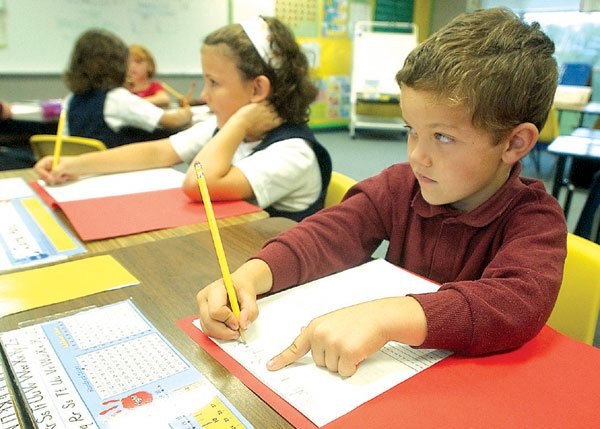GILROY
– More Gilroy schools are mixing students from different grade
levels into the same classrooms this school year in order to
maintain reduced class sizes while trying to cut costs.
By Lori Stuenkel
GILROY – More Gilroy schools are mixing students from different grade levels into the same classrooms this school year in order to maintain reduced class sizes while trying to cut costs.
However, combination classes are a controversial practice in public school districts. Their purpose is to keep kindergarten through third-grade classes within the required 20-to-1 student-teacher ratio so districts can receive state funding for class-size reduction. And they’re becoming more common as budgets are tightened, because they allow districts to hire fewer teachers.
“Given the choice, I’d rather not have combo classes, but it’s just a reality of public schools at this point,” Superintendent Edwin Diaz said.
For instance, instead of splitting a group of 30 first-grade students into two classes of 15 students each, which would require two teachers, districts place the additional 10 students into a class with 10 kindergarten students.
There are currently eight combination classes in five of Gilroy Unified’s eight elementary schools. El Roble and Las Animas elementary schools each have one combination class, while Luigi Aprea, Rod Kelley and Rucker elementary schools each have two. That number may decrease as enrollment continues to settle, said Juanita Contin, director of student enrollment
GUSD had fewer than four combination classes last year, although eight is still a low number, Diaz said.
“We’ve tried to keep the number of combination classes to a minimum, and I think we’ve done that, given our size,” he said.
The Gilroy Teachers Association’s main concern is that combination classes put a strain on teachers, who must be familiar with two different sets of state standards.
“Combination classes are not a good idea,” said Michelle Nelson, president of the GTA. “They’re not good for the teacher, and they’re not good for the students. Some students are not challenged enough, and the other students have trouble keeping up with the others.”
To meet this challenge, school principals made an effort to put more experienced teachers in combination classes and the district has provided those teachers with additional training the past two years.
“There is going to be more expertise, more knowledge of the curriculum (with experienced teachers),” said Olivia Schaad, director of curriculum and instruction.
Christine Shiels, who teaches the combination second- and third-grade class at Rod Kelley, appears ready for the challenge. In her 12-year teaching career, she has taught five combination classes, although this is her first year with GUSD.
“It is definitely more challenging as a teacher to be as organized as possible and to present two different standards. I have to really set it up so that I’m able to extend the lessons to meet the needs of both groups,” she said. “I’m feeling more confident being in this position than a teacher who has never done a combination class, because my experience … is definitely helping me this year, even in a new district.”
The 12 second-graders and eight third-graders in Shiels’ class are adjusting well to the unconventional format, she said.
For parents, the idea of combination classes also takes some getting used to.
“The first day there were some concerned parents,” Shiels said. “It was hard because they didn’t quite understand why they were chosen, but once we explained it to them and their parents, they felt better about it.”
While combination classes might not be ideal, they can work, teachers and district officials agreed.
The district has a year-old grouping system at elementary schools that helps teachers instruct all students at a challenging level, Schaad said. Students from each grade level are placed in groups based on their level of ability. The groups include various students from each class who meet with a designated teacher to study the core subjects of reading, writing and mathematics.
“Grouping works, because you can teach to the level where the group is, and it does make it easier for the teachers,” Nelson said.
Teachers have a much smaller range of abilities within the group than they would see in a normal class so they can better tailor their lessons.
Combination classes allow more Gilroy students to attend their neighborhood school, Contin said. Rather than bus the additional students to a school in another area, they can join a combination class at their designated school.
GUSD voluntarily participates in the state class-size reduction program, launched in 1996, which provides funding for districts maintaining the 20-to-1 ratio for grades K-3. Combining students from two grade levels into one class allows the district to keep K-3 classes within that ratio.
“Students don’t enroll in nice increments of 20,” said Contin. “They may come in as many as 30.”
The state provides districts with $906 per student for each K-3 class with an average enrollment of 20.44 students between the start of the school year and mid-spring. The 20.44 average allows districts some flexibility in moving students or accommodating migrant students because classes can exceed the 20-to-1 ratio for a short period of time, Contin said.
Although the state class-size reduction program was supposed to fund itself, GUSD and other participating districts have had to cover some of the costs incurred by hiring more teachers. GUSD paid an additional $365,000 from the general fund to cover those teachers’ salaries.
“Over the years, as (teachers’) salaries and benefits have increased, the amount of money from the state has not kept up,” Diaz said.
In Gilroy, more experienced teachers are choosing to fill open positions at the K-3 level, so the program is costing more, Diaz said.
The district also loses state money when a K-3 class averages more than 20.44 students. The state penalizes the district $906 per student in the larger class.
Last year, a class at El Roble exceeded the average by .01, costing GUSD $19,000 in lost funding, said Keiko Mizuno, director of business services. She said GUSD expects to meet the average in all K-3 classes this year.
In all, GUSD received $2.9 million for class-size reduction to cover the cost of additional teachers last year, but in the end, the program cost the district money, Mizuno said.
As budgets tighten, some districts are further cutting costs by trimming their class-size reduction programs and removing the 20.44 cap for some grade levels and hiring fewer teachers. With district officials predicting more budget cuts next year, the status of class-size reduction and combination classes in Gilroy is up in the air.
“We tried very hard last year in our budget reduction process to keep the (class-size reduction) program,” Diaz said, “But we’re going to have to go through another round of reductions, and we’re going to have to look at that program again. Believe me, it’s something we want to maintain if we can, because we think it has a lot of benefit for the students.”














